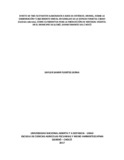Mostrar el registro sencillo del ítem
Efecto de tres sustratos elaborados a base de estiércol animal, sobre la germinación y crecimiento inicial en semillas de la especie forestal cedro (Cedrela Odorata), como alternativa para la producción de material vegetal en el municipio de LLoró, departamento del Chocó.
| dc.contributor.advisor | Díaz Santamaría, William Ricardo | |
| dc.coverage.spatial | cead_-_josé_celestino_mutis | spa |
| dc.creator | Fuentes Serna, Dayler Samir | |
| dc.date.accessioned | 2017-11-16T13:04:46Z | |
| dc.date.available | 2017-11-16T13:04:46Z | |
| dc.date.created | 2017-10-22 | |
| dc.identifier.uri | https://repository.unad.edu.co/handle/10596/13797 | |
| dc.description.abstract | La presente investigación se llevó a cabo en el municipio de Lloró departamento del Chocó – Colombia con el objetivo de evaluar el proceso de germinación de la especie (Cedrela odorata L) como alternativa de sostenibilidad y diversificación productiva de la especie; para lo cual se utilizaron tres tipos de sustratos orgánicos diferentes elaborados a base de estiércol animal, con el siguiente procedimiento; en primera instancia se demarcaron tres zonas diferente para la elaboración del compost, dejando espacio necesario para la circulación y el volteo de las pilas, cada una de estas pilas de sustrato poseía un tipo de estiércol diferente el primero con estiércol de ganado bovino, el segundo con estiércol de cerdo y el tercero con estiércol de aves de corral o gallinaza, teniendo en cuenta que los otros componentes como cascarilla de arroz, tierra negra, carbón de madera en partículas pequeñas, desechos orgánicos triturados y tierra de hormiga se aplicaron a cada sustrato en iguales cantidades pues esto permitió determinar cuál de los tres es el sustrato más apropiado para el proceso de germinación de la especie forestal estudiada. En atención a lo descrito anteriormente podemos destacar en cuanto a la principal variable a evaluar que fue el porcentaje de germinación encontramos que los tratamientos T1 (Tierra en condiciones naturales del territorio y T3 (Porcinaza, suelo, hojarasca, aserrín y restos de alimentos), presentaron el mismo porcentaje de germinación equivalente a 68, 33%. El tratamiento con mayor porcentaje de germinación fue el T4 (Bovinaza, suelo, hojarasca, aserrín y restos de alimentos) alcanzanto un porcentaje del 76,67% y el T2 (Gallinaza, suelo, hojarasca, aserrín y restos de alimentos) fue el de menos porcentaje de germinación logrando que el 50% de las semillas germinaran lo cual no es un porcentaje demasiado bajo en atención a las garantías de germinación de da la empresa empacadoras de semillas de cedro. | spa |
| dc.format | spa | |
| dc.format.mimetype | application/pdf | spa |
| dc.language.iso | spa | spa |
| dc.publisher | Universidad Nacional Abierta y a Distancia UNAD | spa |
| dc.title | Efecto de tres sustratos elaborados a base de estiércol animal, sobre la germinación y crecimiento inicial en semillas de la especie forestal cedro (Cedrela Odorata), como alternativa para la producción de material vegetal en el municipio de LLoró, departamento del Chocó. | spa |
| dc.type | Proyecto aplicado | spa |
| dc.subject.keywords | Especie Forestal - Cedro | spa |
| dc.subject.keywords | Germinación – Semillas | spa |
| dc.subject.keywords | Suelos - Minerales | spa |
| dc.subject.keywords | Sustratos Orgánicos | spa |
| dc.description.abstractenglish | The present investigation was carried out in the municipality of Lloró department of Chocó - Colombia with the objective of evaluating the process of germination of the species (Cedrela odorata L) as an alternative of sustainability and productive diversification of the species; for which three different types of organic substrates made from animal manure were used, with the following procedure; in the first instance, three different areas were demarcated for compost production, leaving enough space for the circulation and turning of the piles, each of these stacks of substrate had a different type of manure, the first with cattle manure, the second with pig manure and the third with poultry manure or chicken manure, taking into account that the other components such as rice husk, black earth, small particle wood char, crushed organic waste and ant soil were applied to each substrate in equal amounts because this allowed to determine which of the three is the most appropriate substrate for the process of germination of the forest species studied. In response to what has been described above, we can highlight the main variable to be evaluated, which was the percentage of germination, that we find that the T1 treatments (Earth in natural conditions of the territory and T3 (Swine, soil, litter, sawdust and food remains), they presented the same percentage of germination equivalent to 68, 33% The treatment with the highest percentage of germination was T4 (Bovinaza, soil, litter, sawdust and food remains) reaching a percentage of 76.67% and T2 (Gallinaza, soil, litter, sawdust and food remains) was the lowest percentage of germination achieving 50% of the seeds germinate which is not too low a percentage in response to the germination guarantees of the company cedar seed packing plants . | spa |
| dc.subject.category | Tecnología Agroforestal | spa |
| dc.rights.accesRights | info:eu-repo/semantics/openAccess | spa |
| dc.rights.acceso | Abierto (Texto Completo) | spa |















